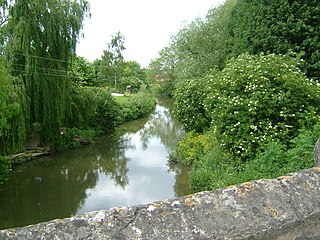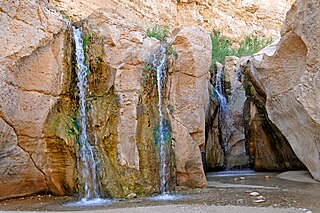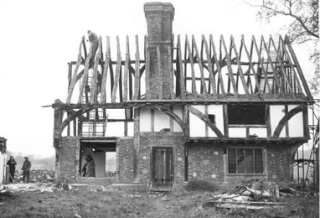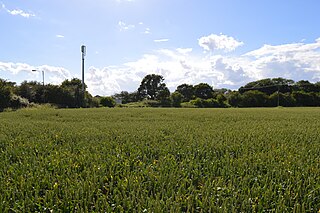
Old Shawneetown is a village in Gallatin County, Illinois, United States. As of the 2010 census, the village had a population of 193, down from 278 at the 2000 census. Located along the Ohio River, Shawneetown served as an important United States government administrative center for the Northwest Territory. The village was devastated by the Ohio River flood of 1937. The village's population was moved several miles inland to New Shawneetown.

The River Blackwater is a river in Essex, England. It rises as the River Pant in the northwest of the county, just east of Saffron Walden, and flows in a generally southeast direction to Bocking, near Braintree, via Great Sampford and Great Bardfield. At Bocking, it becomes the River Blackwater, and veers east to flow past Bradwell Juxta Coggeshall and Coggeshall. It then veers south, flowing past Kelvedon and Witham, before reaching Maldon. There, it veers east again and empties into the Blackwater Estuary, which in turn meets the North Sea at Mersea Island.

The Swale is a tidal channel of the Thames estuary that separates the Isle of Sheppey from the rest of Kent. On its banks is a 6,509.4-hectare (16,085-acre) biological Site of Special Scientific Interest which stretches from Sittingbourne to Whitstable in Kent. It is also a Ramsar internationally important wetland site and a Special Protection Area under the European Union Directive on the Conservation of Wild Birds. Parts of it are a Nature Conservation Review site, Grade I, National Nature Reserves, a Kent Wildlife Trust nature reserve and a Local Nature Reserve.

Pluckley railway station is on the South Eastern Main Line in England, serving the village of Pluckley, Kent, which is approximately 1.2 miles (2 km) to the north. It is 50 miles 35 chains (81.2 km) down the line from London Charing Cross. The station and all trains that serve the station are operated by Southeastern.

The Nore is a long bank of sand and silt running along the south-centre of the final narrowing of the Thames Estuary, England. Its south-west is the very narrow Nore Sand. Just short of the Nore's easternmost point where it fades into the channels it has a notable point once marked by a lightship on the line where the estuary of the Thames nominally becomes the North Sea. A lit buoy today stands on this often map-marked divisor: between Havengore Creek in east Essex and Warden Point on the Isle of Sheppey in Kent.

Bedfords Park is public open space of 215 acres or approximately 87½ hectares near Havering-atte-Bower in the London Borough of Havering in England. It is one of three large parklands around Havering-atte-Bower; the others are Havering Country Park and Pyrgo Park.

Jaywick Martello Tower is a renovated Martello tower at Jaywick, 2.7 miles (4.3 km) south-west of Clacton-on-Sea, Essex. It now functions as an arts, heritage and community venue.

The River Beult is a tributary of the River Medway in South East England.

Tamerza is th largest mountain oasis in Tunisia, known as Ad Turres by the Romans. It has a canyon and an abandoned old town. The town was abandoned after the river flooded for 22 days in 1969. It is located north of the salt lakes and receives fresh water from the nearby hills. It is in the hillcountry near the border with Algeria, and is 6km from Mides.

Branica Radzyńska is a village in the administrative district of Gmina Radzyń Podlaski, within Radzyń Podlaski County, Lublin Voivodeship, in eastern Poland.

The Wealden hall house is a type of vernacular medieval timber-framed hall house traditional in the south east of England. Typically built for a yeoman, it is most common in Kent and the east of Sussex but has also been built elsewhere. Kent has one of the highest concentrations of such surviving medieval timber-framed buildings in Europe.

Hempstead is a village and civil parish in the Uttlesford district of Essex, England.
The Mount Savage Iron Works operated from 1837 to 1868 in Mount Savage, Maryland. The ironworks were the largest in the United States in the late 1840s, and the first in the nation to produce heavy rails for construction of railroads. The works were established in an area adjacent to mines for coal, iron ore and fire clay. Facilities included blast furnaces, puddling furnaces, a rolling mill, iron refineries, coke production and brick production.

Leslie H. Kemp and Frederick E. Tasker were English architects who practiced in the 1930s as Kemp & Tasker.
Old County Ground is a cricket ground in Brentwood, Essex. The first recorded match on the ground was in 1876, when Essex played Suffolk in a non first-class match.

Marks Hall was a Jacobean country house some 2 miles (3.2 km) north of Coggeshall in Essex, England. Previously a timber manor house, the 17th-century brick building was demolished in 1950.

Marks Tey Brickpit is a 29.5 hectare geological Site of Special Scientific Interest in Marks Tey in Essex. It is a Geological Conservation Review site.

St Mary's Church, Woodford is the ancient parish church for Woodford in east London, on the High Road in what is now South Woodford in the London Borough of Redbridge. It is known to have existed by the 12th century. Its rector in the 1520s was John Larke. Its medieval west tower and spire were in dangerously poor repair by 1705 and in 1708 it was replaced with a brick tower The medieval church was substantially rebuilt in brick in the Gothic style in 1816. Population expansion led to the construction of the new churches of St Paul's in 1854 and All Saints in 1874, both within the parish.

South Thames Estuary and Marshes is a 5,289-hectare (13,070-acre) biological Site of Special Scientific Interest which stretches between Gravesend and the mouth of the River Medway in Kent. Part of it is a Nature Conservation Review site, Grade I, and part is a Royal Society for the Protection of Birds nature reserve. It is part of the Thames Estuary and Marshes Ramsar internationally important wetland site and Special Protection Area under the European Union Directive on the Conservation of Wild Birds.

George Smeed is a Thames barge built in 1882 by Smeed Dean & Co. Ltd. in Murston.



















